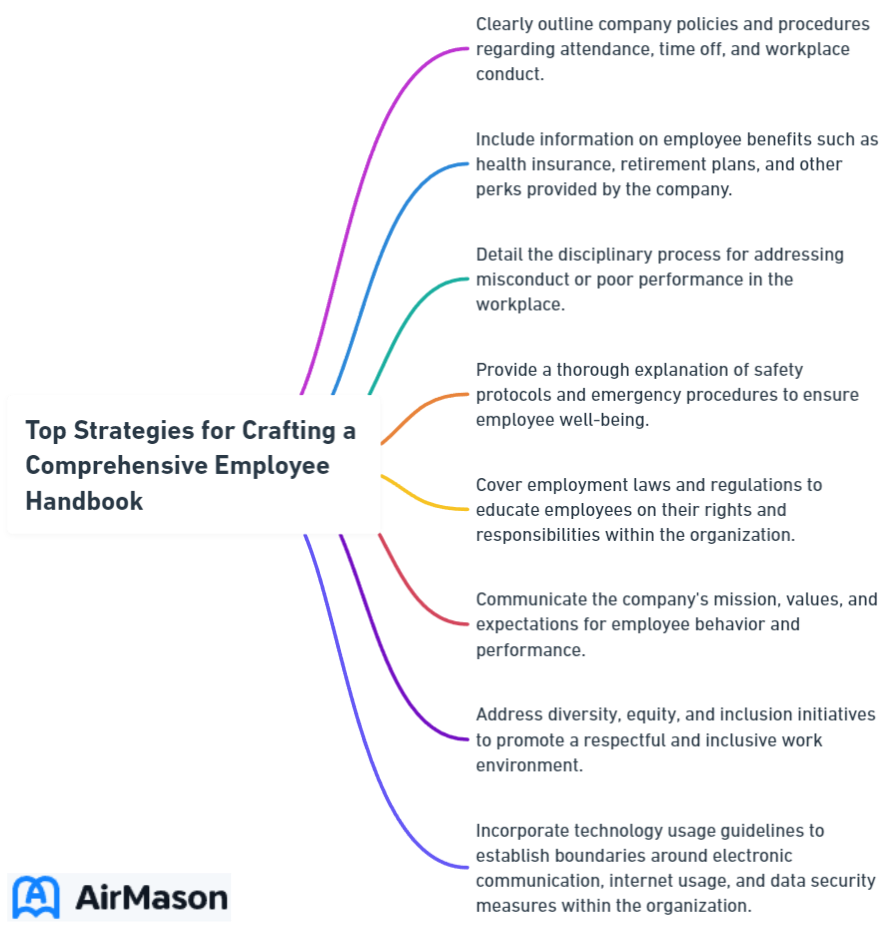
Crafting an employee handbook? Whether you’re starting from scratch or refining an existing guide, it’s crucial to address core elements like policy communication, cultural integration, and legal adherence. This article cuts through the complexity, offering you a focused blueprint for an employee handbook that aligns with your business values and legal obligations, ensuring a well-informed and cohesive workforce.
Key Takeaways
- Employee handbooks serve a dual purpose of communicating the company’s core vision and purpose while setting clear expectations and protocols for employee responsibilities and managerial conduct.
- Handbooks are crucial for establishing company culture and values, ensuring legal compliance (by including necessary federal and state laws), and highlighting the commitment to diversity, equity and inclusion.
- Regular updates and revisions are vital to maintain the relevance of an employee handbook, ensuring it reflects current laws, company practices, and adapts to feedback, with a design that is accessible and engaging for employees.

The Importance of an Employee Handbook
Communicating the company’s core vision and purpose is a primary function of an employee handbook. HR leaders find it an invaluable resource and it offers continuous support to employees by establishing explicit expectations concerning employee responsibilities, including protocols for requesting time off and managing absences. This handbook educates employees on what to expect from management and leadership, including organizational objectives, leadership styles, and endorsed management practices.
The handbook also ensures clarity by consistently communicating key company policies and ensures consistent enforcement throughout the organization. It provides information on internal support avenues, prompting employees to seek assistance within the organization first before reaching out to external parties.
Establishing Company Culture and Values

As a critical introduction to the company’s culture, the employee handbook plays a substantial role in onboarding new employees and providing them with a sense of pride and belonging to increase productivity sooner. It should clearly define the company’s values and mission, and illustrate how these are integral to employee behavior, organizational decisions, and the overall work environment. New employees employee handbooks serve as a valuable resource for understanding expectations and guidelines within the company.
Language that aligns with the company’s cultural values should be used, alongside providing relevant examples and scenarios that depict the desired behaviors in the workplace. Additionally, outlining a diversity, equity, and inclusion policy is necessary, highlighting the company’s commitment to a respectful workplace, and explaining procedures for reporting and dealing with discrimination.
Legal Compliance and Risk Management
The crafting of an effective employee handbook crucially involves ensuring legal compliance and risk management. This involves incorporating policies that reflect federal, state, and local employment laws, thereby reducing the risk of employee claims and disputes.
Employment Laws and Regulations
Inclusion of fundamental federal laws is necessary in the employee handbook such as:
- Fair Labor Standards Act (FLSA)
- Family and Medical Leave Act (FMLA)
- Occupational Safety and Health Act (OSHA)
- Title VII of the Civil Rights Act
- Americans with Disabilities Act (ADA)
- Age Discrimination in Employment Act (ADEA)
Not only this, but guidelines from the Equal Employment Opportunity Commission (EEOC) and protections under the National Labor Relations Act (NLRA) must also be communicated in the handbook.
State-specific employment laws with requirements differing from federal laws should be clearly outlined to ensure regional compliance. In addition, the handbook should detail the company’s equity and anti-discrimination policies, clearly stating the prevention of any form of harassment or unfair treatment related to company property.
The handbook necessitates regular updates, taking into account recent legislative changes like amendments by the National Labor Relations Board (NLRB), the Pregnant Workers Fairness Act (PWFA), and the PUMP Act.
Confidentiality and Data Protection
Confidentiality and data protection are paramount in today’s digital age. The employee handbook should contain a comprehensive privacy policy that lays out the types of personal information collected from employees, the measures taken to protect it, and the purposes for which it is used. Confidential employee information, such as the employee’s personnel file, should have access restricted to a need-to-know basis, utilizing strong encryption techniques to safeguard against unauthorized breaches.
Additionally, conducting regular cybersecurity training is vital to ensure that employees are aware of best practices for handling sensitive information and adhering to the company’s privacy policies. The handbook should also include specific security and confidentiality policies, as well as a whistleblower policy to permit employees to report unethical or illegal activities without fear of retaliation.
Key Components of an Effective Employee Handbook

A comprehensive employee handbook, also known as your own employee manual, covers all aspects of an employee’s journey in the company, including:
Employment basics
Company policies and procedures
Employee benefits and perks
Performance management and development guidelines
Company Policies and Procedures

Employee handbooks typically serve as the backbone, formed by the company policies and procedures. An employee handbook template can be a useful tool in ensuring that the handbook clearly outlines rules regarding attendance and provides an explanation of the recruitment process. It is also important to detail how employees will be compensated, including pay periods, payroll deductions, and the compensation structure. With employees employee handbooks, consistency and clarity in communication are key to maintaining a productive work environment. Creating your own employee handbook can help ensure that all these aspects are covered effectively.
The employee handbook must include employee handbook examples that cover:
- A code of conduct outlining standards for employee behavior
- Expected conduct
- A clear dress code to ensure all employees understand the wardrobe expectations
- Work schedules
- The company’s attitude towards flexible work arrangements
- The environment
- A fair and transparent disciplinary process
These elements should be communicated clearly in the handbook.
Employee Handbook Template
An employee handbook template is an essential document for any organization looking to establish clear guidelines and expectations for its employees. This comprehensive tool provides a framework for addressing various topics, including company policies, procedures, and code of conduct. By utilizing an employee handbook template, businesses can ensure consistency in communication and promote transparency across all departments. Moreover, customizing the template to fit the organization’s specific needs allows for the inclusion of relevant information tailored to the company culture and industry standards. With an employee handbook template in place, employers can effectively onboard new hires, streamline HR processes, and maintain compliance with legal requirements.
Employee Benefits and Perks

The satisfaction and retention of existing employees heavily rely on benefits and perks. The employee handbook includes the following benefits:
- Vacations
- 401(k)
- Health insurance
- Paid parental leave
It also includes policies and eligibility requirements.
Leave policies covered include family medical leave, worker’s compensation, paid-time-off policies, and paid holiday schedules. Furthermore, the handbook explains health insurance options, including COBRA coverage, long and short-term disability benefits.
Performance Management and Development
Every employee’s journey in a company lays significant emphasis on performance management and development. The employee handbook should outline annual performance review schedules and criteria for evaluations. It also informs employees about the requirements for raises and promotions, as well as how the company process employees in terms of growth opportunities.
The handbook provides information on professional development opportunities, including coaching and sabbaticals, that encourage employee growth. Compensation and development sections of the handbook show the company’s value to employees, motivating them and explaining pay and rewards.
Finally, details on performance improvement plans and consequences for not meeting performance goals are covered to address failures effectively.
Design and Accessibility

The importance of an employee handbook’s design and accessibility is on par with its contents. To ensure accessibility, companies should keep a copy of the employee handbook readily available to all employees, both in physical and digital formats, enabling access from multiple devices and platforms, including in a mobile-friendly version.
The use of interactive visual elements, real-life examples, and visually appealing design can enhance the handbook’s engagement and should be considered in its design. The handbook should also feature a consistent writing style and logical structure, with sections and subheadings, to enhance its readability and navigability.
Updating and Revising Your Employee Handbook
To maintain its effectiveness, the employee handbook should be kept relevant and updated. Regular reviews and updates to the employee handbook are essential to ensure the content reflects current laws and company practices, with an annual review being a good standard and revisions taking place every one to two years or when significant changes occur.
The employee handbook should be a living document, evolving along with the company’s core values and employing feedback mechanisms to maintain its relevance and usefulness. While keeping the handbook up-to-date is key, it’s also important to avoid too frequent revisions to prevent employee confusion and change fatigue.
Tips for Successful Employee Handbook Implementation
The importance of implementing the employee handbook is as significant as its crafting. Here are some steps to follow:
- Introduce the employee handbook through a formal announcement email.
- Schedule a meeting to introduce the handbook.
- Include time during new hire orientation for employees to review the handbook.
Ensure the handbook is easily accessible, provide clear instructions on how to access it, and encourage employees to familiarize themselves with its contents. Regularly update the handbook, train managers on new policies, and align them with legal requirements and best practices. Additionally, inform employees about these updates to keep them well-informed.
Summary
In conclusion, a well-structured employee handbook is crucial for clear and effective communication within a company. It not only sets clear expectations but also serves as a guide for employees to understand their responsibilities, the company culture, and the various benefits they can avail. Regular updates and revisions are necessary to ensure its relevance and compliance with current laws and company practices.
Frequently Asked Questions
What should be avoided in an employee handbook?
In an employee handbook, it’s important to avoid including contractual restrictions like nondisclosure and noncompete agreements, while also ensuring the handbook is not too long. It’s also crucial to include all legally obligated policies and information on leaving the company.
What is a better name for an employee handbook?
Consider renaming the employee handbook as Employee Guide or Employee Manual to give it a more user-friendly and approachable title. This can help to improve employee engagement and understanding.
Does a small business need an employee handbook?
Yes, a small business needs an employee handbook to inform employees about policies, procedures, expectations, and their rights and protections under state and federal law. This written document helps to consolidate important information for your employees.
How can I make my employee handbook more interesting?
To make your employee handbook more interesting, consider incorporating images, illustrations, and other visuals to break up the text and make it visually appealing. Additionally, using a conversational tone and including colors, visuals, and whimsical fonts can help create a more engaging and easy-to-understand handbook. This will make it easier for your employees to connect with the content and understand the workplace culture without feeling overwhelmed.
What must be included in an employee handbook?
The employee handbook should include sections covering the employer’s mission statement, equal employment opportunity statement, contractual disclaimer, at-will employment statement (where allowed), purpose of the employee handbook, and background information on the company, as well as information on company mission, vision and values, anti-harassment and non-discrimination policy, code of conduct, dress code, communications policy, compensation and benefits information, and reviews, promotions and raises.
Important Disclaimer:
Please be aware that the content on this page has been generated by using artificial intelligence language models and may contain errors, inconsistencies, or outdated information. It is provided as-is without any warranties or guarantees of accuracy.
We strongly recommend using this content as a starting point for further research. We disclaim any liability for damages or losses resulting from the use or reliance on this content.